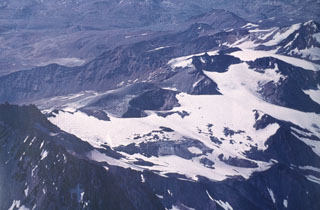Report on Planchon-Peteroa (Chile) — 4 May-10 May 2011
Smithsonian Institution / US Geological Survey
Weekly Volcanic Activity Report, 4 May-10 May 2011
Managing Editor: Sally Sennert.
Please cite this report as:
Global Volcanism Program, 2011. Report on Planchon-Peteroa (Chile) (Sennert, S, ed.). Weekly Volcanic Activity Report, 4 May-10 May 2011. Smithsonian Institution and US Geological Survey.
Planchon-Peteroa
Chile
35.223°S, 70.568°W; summit elev. 3977 m
All times are local (unless otherwise noted)
SERNAGEOMIN reported that, based on video camera data, photographs, and observations during an overflight on 4 May, activity at Planchón-Peteroa was relatively stable during 30 April-8 May. Explosions lasting about 30 seconds produced ash plumes that rose at most 1 km above the crater and drifted tens of kilometers E, NE, NNE, NNW and NW. During 4-5 May material fell in Minera Río Teno (about 70 km NW) and Las Leñas, Argentina (45 km ENE). The Alert Level remained at Level 3, Yellow. Based on ODVAS web camera observations, the Buenos Aires VAAC reported that on 9 May gas-and-ash plumes rose to an altitude of 4.3 km (14,000 ft) a.s.l. and rapidly dissipated to the SE.
Geological Summary. Planchón-Peteroa is an elongated complex volcano along the Chile-Argentina border with several overlapping calderas. Activity began in the Pleistocene with construction of the basaltic-andesite to dacitic Volcán Azufre, followed by formation of basaltic and basaltic-andesite Volcán Planchón, 6 km to the north. About 11,500 years ago, much of Azufre and part of Planchón collapsed, forming the massive Río Teno debris avalanche, which traveled 95 km to reach Chile's Central Valley. Subsequently, Volcán Planchón II was formed. The youngest volcano, andesitic and basaltic-andesite Volcán Peteroa, consists of scattered vents between Azufre and Planchón. Peteroa has been active into historical time and contains a small steaming crater lake. Historical eruptions from the complex have been dominantly explosive, although lava flows were erupted in 1837 and 1937.
Sources: Buenos Aires Volcanic Ash Advisory Center (VAAC), Servicio Nacional de Geología y Minería (SERNAGEOMIN)

